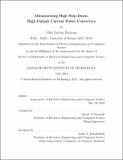| dc.contributor.advisor | Perreault, David J. | |
| dc.contributor.author | Ranjram, Mike Kavian | |
| dc.date.accessioned | 2022-01-14T15:05:38Z | |
| dc.date.available | 2022-01-14T15:05:38Z | |
| dc.date.issued | 2021-06 | |
| dc.date.submitted | 2021-06-23T19:40:10.123Z | |
| dc.identifier.uri | https://hdl.handle.net/1721.1/139348 | |
| dc.description.abstract | Power conversion systems providing high voltage step-down capability at high output current are required in many applications, such as data center servers, electric vehicle charging, and USB power delivery. Converter miniaturization is a critical but especially challenging design goal, and transformers present a key bottleneck in this effort. To address this challenge, a new paradigm for magnetic component design is proposed in which magnetic and electronic elements are viewed as a single ``coupled electronic and magnetic system'' (CEMS).
The first proposed CEMS is the Variable Inverter/Rectifier Transformer (VIRT), which enables a transformer with fractional and reconfigurable effective turns ratios (e.g. 12:0.5, 12:2/3, 12:1, and 12:2). Its wide gain variation and high step-down capability are utilized in a 120-380V input, 5-20V, 5A/36W output dc/dc converter having a peak efficiency of 96% and greater than 93% efficiency across the wide range. The VIRT is also employed in a two-stage universal ac input, 5/9/12V, 5A/50W output portable charger having a component power density of 55W/in3 and a peak end-to-end efficiency of 95.7%.
Challenges associated with leveraging highly interleaved high-layer-count planar windings - another means for handling high current - are elucidated and mitigation strategies are proposed. A novel winding termination strategy is demonstrated to reduce ac resistance by more than 40% in a highly interleaved design.
A CEMS that is especially well suited for processing high output current is derived by combining the VIRT with popular multi-phase concepts. The resulting split-phase half-turn VIRT is employed in a 380V input, 12V/1kW output data center supply having a peak efficiency of 97.7% and a full-load efficiency of 97.1% with a transformer volume up to 36% smaller than best-in-class alternatives. Finally, a generalized modeling framework for developing new CEMS implementations is presented. | |
| dc.publisher | Massachusetts Institute of Technology | |
| dc.rights | In Copyright - Educational Use Permitted | |
| dc.rights | Copyright MIT | |
| dc.rights.uri | http://rightsstatements.org/page/InC-EDU/1.0/ | |
| dc.title | Miniaturizing High Step-Down, High Output Current Power Converters | |
| dc.type | Thesis | |
| dc.description.degree | Ph.D. | |
| dc.contributor.department | Massachusetts Institute of Technology. Department of Electrical Engineering and Computer Science | |
| dc.identifier.orcid | https://orcid.org/0000-0002-6513-1488 | |
| mit.thesis.degree | Doctoral | |
| thesis.degree.name | Doctor of Philosophy | |
